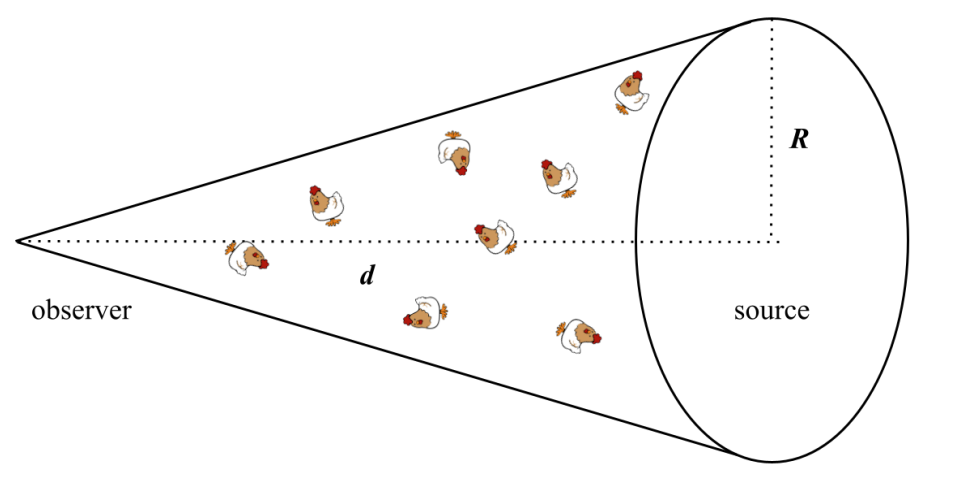Nuggets of Wisdom Explained (Part 2)
Hi folks!
Let's ignore that delay... So anyway. CHICKENS.
Detection by Photometric Extinction
Sounds complicated, and you know what? It is. But I'll attempt to explain it both simply and accurately.
What is photometric extinction?
"Photometric" is a fancy word for "light," or dealing with the unit of light called "photons." When a light source releases a lot of photons, it's bright; when it doesn't give many, it's dim. And when there's something between us and a bright source, it simply appears dim because that stuff is in the way. Like fog between you and a street light: you know the light is (intrinsically) brighter than it appears, and that it only looks dim because of the fog. In astronomy, our light sources are stars or distant galaxies, and the "fog" is gas and dust (and chickens??) between the source and the Earth - this is called the interstellar medium, or ISM. Dimming the light is known as extinction.
 |
| How many chickens could be between us and a source before we notice the extinction of light? |
How much photometric extinction?
The tricky part is knowing how bright the light source should be (intrinsic or absolute brightness) in order to know how much ISM is inbetween us and the light source. If you can accurately measure a street lamp on a night that isn't foggy, then you know how bright it should be; measuring how bright it appears on a foggy night and comparing to a clear night can tell you how much extinction there is due to the fog. The issue is that there isn't a "clear night" in space - the gas is always in the way. So we need to be a bit more clever.
Instead, we can try and understand the properties of the to estimate how much extinction occurs. For example, if the ISM is made of chickens, then some properties that contribute to extinction include:
- the size of the chickens (known)
- the size of the source (easy to figure out)
- the distance from us to the chickens (hard to know)
- the distance to the source (easy to figure out), and most importantly
- how many chickens there are (AKA the chicken density function).
How many chickens?
We're trying to figure out how high the chicken density function could be before we notice there are chickens blocking light sources. Take the Sun, for example. We can know how bright the Sun should be with an accuracy of 0.01%. How many chickens could cause photometric extinction of the Sun within that 0.01%?
10^18 chickens within the volume of Earth's orbit. Wow.
A more rigorous constraint
If not by the light of the Sun, we can be even pickier to narrow down how many chickens there could be before we notice. To put it very briefly: a type of star called a red giant gives off a very specific amount of light, and we can be really sure of how much light there should be. That means there can't be a lot of photometric extinction, and there can't be too much stuff in the way before we notice it's there. In fact, this is how we measure how much of the ISM there is when it's otherwise somewhat invisible. With the Hubble Space Telescope and an even higher accuracy, the wiggle room for hidden chickens narrows it down to 10^23 chickens per cubic parsec. Ultimately this will define the limit we're looking for -- any more chickens would affect measurements enough to be noticeable.
Part 3 should come out in just a peck!
Also, in case I haven't said it before, feel free to ask questions in the comments. This blog is me practicing science communication, and I don't pretend I'm perfect at it. If you don't understand something, then I haven't explained it well enough.
EDIT: Here's Part 3



Comments
Post a Comment